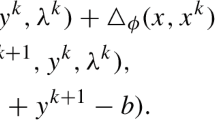Abstract
We propose a homogeneous model for the class of mixed horizontal linear complementarity problems. The proposed homogeneous model is always solvable and provides the solution of the original problem if it exists, or a certificate of infeasibility otherwise. Our formulation preserves the sparsity of the original formulation and does not reduce to the homogeneous model of the equivalent standard linear complementarity problem. We study the properties of the model and show that interior-point methods can be used efficiently for the numerical solutions of the homogeneous problem. Numerical experiments show convincingly that it is more efficient to use the proposed homogeneous model for the mixed horizontal linear complementarity problem than to use known homogeneous models for the equivalent standard linear complementarity problem.
Similar content being viewed by others
References
Andersen, E., Ye, Y.: A computational study of the homogeneous algorithm for large-scale convex optimization. Comput. Optim. Appl. 10(3), 243–280 (1998)
Andersen, E., Ye, Y.: On a homogeneous algorithm for the monotone complementarity problem. Math. Program. 84(2), 375–399 (1999)
Anitescu, M., Lesaja, G., Potra, F.A.: Equivalence between different formulations of the linear complementarity problem. Optim. Methods Softw. 7(3), 265–290 (1997)
Anstreicher, K.: On interior algorithms for linear programming with no regularity assumptions. Oper. Res. Lett. 11(7), 209–212 (1992)
Bonnans, J.F., Gonzaga, C.C.: Convergence of interior point algorithms for the monotone linear complementarity problem. Math. Oper. Res. 21(1), 1–25 (1996)
Czyzyk, J., Mehrotra, S., Wright, S.J.: PCx user guide. Technical Report OTC 96/01. Optimization Technology Center, Argonne National Laboratory and Northwestern University (1996)
Gertz, E.M., Wright, S.J.: Object-oriented software for quadratic programming. ACM Trans. Math. Softw. 29(1), 58–81 (2003)
Gondzio, J.: HOPDM (version 2.12)—a fast LP solver based on a primal-dual interior point method. Eur. J. Oper. Res. 85, 221–225 (1995)
Gowda, M.S.: Reducing a monotone horizontal LCP to an LCP. Appl. Math. Lett. 8(1), 97–100 (1995)
Güler, O.: Generalized linear complementarity problems. Math. Oper. Res. 20(2), 441–448 (1995)
Huang, K.L., Mehrotra, S.: Solution of monotone complementarity and general convex programming problems using a modified potential reduction interior point method. INFORMS J. Comput. 29(1), 36–53 (2017)
Karmarkar, N.K.: A new polynomial-time algorithm for linear programming. Combinatorica 4, 373–395 (1984)
Lin, Y., Yoshise, A.: A homogeneous model for mixed complementarity problems over symmetric cones. Vietnam J. Math. 35, 541–562 (2007)
Lustig, I., Marsten, R.E., Shanno, D.F.: On implementing Mehrotra’s predictor–corrector interior-point method for linear programming. SIAM J. Optim. 2(3), 435–449 (1992)
Mehrotra, S.: On the implementation of a primal-dual interior point method. SIAM J. Optim. 2(4), 575–601 (1992)
Monteiro, R.D.C., Pang, J.S.: Properties of an interior-point mapping for mixed complementarity problems. Math. Oper. Res. 21(3), 629–654 (1996)
Monteiro, R.D.C., Pang, J.S.: On two interior-point mappings for nonlinear semidefinite complementarity problems. Math. Oper. Res. 23(1), 39–60 (1998)
Petra, C.G.: Homogenization of mixed horizontal LCPs and applications. Ph.D. thesis, University of Maryland, Baltimore County (2009)
Sznajder, R., Gowda, M.S.: Generalizations of P0- and P-properties; extended vertical and horizontal linear complementarity problems. Linear Algebra Appl. 223–224, 695–715 (1995)
Ye, Y.: On homogeneous and self-dual algorithms for LCP. Math. Program. 76(1), 211–221 (1997)
Ye, Y., Todd, M.J., Mizuno, S.: An \({O}(\sqrt{n}{L})\)-iteration homogeneous and self-dual linear programming algorithm. Math. Oper. Res. 19(1), 53–67 (1994)
Yoshise, A.: Interior point trajectories and a homogeneous model for nonlinear complementarity problems over symmetric cones. SIAM J. Optim. 17(4), 1129–1153 (2006)
Yoshise, A.: A homogeneous algorithm for monotone complementarity problems over symmetric cones. Front. Sci. Ser. 49, 83 (2007)
Zhang, D., Zhang, Y.: A Mehrotra-type predictor-corrector algorithm with polynomiality and \(Q\)-subquadratic convergence. Ann. Oper. Res. 62, 131–150 (1996)
Zhang, Y.: Solving large-scale linear programs by interior-point methods under the MATLAB environment. Technical Report TR96-01. University of Maryland Baltimore County (1996)
Acknowledgements
The work of Cosmin Petra was done the auspices of the U.S. Department of Energy by Lawrence Livermore National Laboratory under Contract DE-AC52-07NA27344. The work of Florian Potra was supported by the National Science Foundation under Grant No. DMS-1311923.
Author information
Authors and Affiliations
Corresponding author
Rights and permissions
About this article
Cite this article
Petra, C.G., Potra, F.A. A homogeneous model for monotone mixed horizontal linear complementarity problems. Comput Optim Appl 72, 241–267 (2019). https://doi.org/10.1007/s10589-018-0035-x
Received:
Published:
Issue Date:
DOI: https://doi.org/10.1007/s10589-018-0035-x




